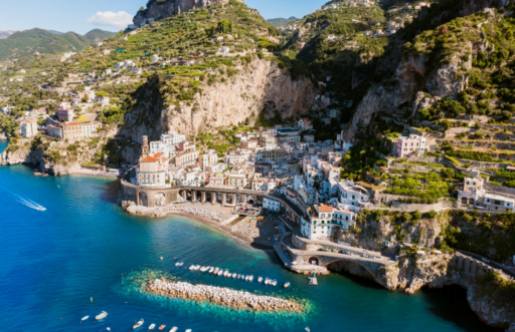Nestled along the breathtaking Amalfi Coast lies the charming town of Amalfi, known for its stunning cliffs, turquoise waters, and vibrant culture. But beyond its picturesque facade, Amalfi holds a rich history that dates back to ancient times. As we delve into the origins of Amalfi, we uncover a fascinating tale of Greek and Roman influence, shaping the town into the beloved destination it is today. Join us on a journey back in time as we explore the hidden treasures of Amalfi's past.

Uncovering the Roman Ruins of Amalfi
As visitors explore the winding streets and charming piazzas of Amalfi, they are often surprised to stumble upon the remnants of ancient Roman structures scattered throughout the city.
One of the most notable Roman ruins in Amalfi is the Duomo di Amalfi, also known as the Cathedral of St. Andrew. This imposing church, with its stunning facade and intricately detailed mosaics, was originally built in the 9th century on the site of a Roman temple dedicated to the god Apollo. Visitors can still see Roman columns and marble slabs integrated into the cathedral's architecture, a testament to the city's Roman past.
Another significant Roman ruin in Amalfi is the Chiostro del Paradiso, or Cloister of Paradise. This 13th-century cloister features a beautiful central courtyard lined with elegant columns and intricate arches, but what many visitors may not realize is that the cloister was built upon the remains of a Roman villa. The blending of Roman and medieval architecture in the Chiostro del Paradiso offers a unique glimpse into Amalfi's layered history.
As visitors continue to explore Amalfi, they may come across other Roman ruins such as ancient walls, thermal baths, and even a Roman watchtower overlooking the sea. These scattered remnants of Roman civilization serve as a reminder of the city's long and storied history, from its humble origins as a Roman trading post to its eventual rise as a powerful maritime republic.
In uncovering the Roman ruins of Amalfi, visitors can gain a deeper appreciation for the city's rich heritage and the enduring influence of the ancient Romans on the culture and architecture of this picturesque coastal town.
Myth and History: Exploring the Ancient Origins of Amalfi
According to legend, the city was founded by Hercules himself, who was said to have erected a tomb in the area after completing his tenth labor. This mythological connection underscores the city's ancient roots and the belief that it held a significant importance in antiquity.
Historically, Amalfi was a prosperous maritime republic during the Middle Ages, known for its strategic location along the Mediterranean coast and its flourishing trade relationships with the Byzantine Empire and North Africa. However, its origins are even older, dating back to the Greek and Roman periods.
The Greeks were the first to establish a presence in the region, founding the city of Melphi in the 6th century BC. This Greek influence can still be seen in the architecture and layout of the city, as well as in its name, which is derived from the Greek word for "to reap" or "to gather."
Following the Greek period, Amalfi came under Roman rule and became an important hub for trade and commerce. The Romans built roads, aqueducts, and villas in the area, shaping the landscape and leaving behind a legacy of architectural marvels. The most notable of these is the Villa Rufolo, a luxurious residence perched on the cliffs overlooking the Mediterranean Sea.
In conclusion, the ancient origins of Amalfi are a fascinating blend of myth and history, with its roots stretching back to the mythical exploits of Hercules and the glory days of the Roman Empire. By delving into the city's past, we gain a deeper appreciation for its cultural heritage and the enduring legacy of its ancient inhabitants.
Amalfi's Greek and Roman Heritage: A Historical Overview
The town's heritage is deeply intertwined with both Greek and Roman influences, shaping its cultural identity and architectural landscape.
The Greek presence in Amalfi can be traced back to the 6th century BC when Greek settlers established colonies along the coast of southern Italy. These early settlers brought with them their language, customs, and architectural styles, which left a lasting impact on the region. The influence of Greek culture can still be seen in Amalfi's architecture, particularly in its iconic white-washed buildings and terraced hillsides.
During the Roman period, Amalfi flourished as a bustling port town and trading hub. The Romans built villas, baths, and temples in the area, showcasing their architectural prowess and engineering skills. The town's strategic location along the coast made it an important stop along the trade routes of the Mediterranean, further solidifying its importance in the ancient world.
The Romans also left behind a number of ruins and artifacts that provide valuable insights into daily life in Amalfi during this time. The remains of a Roman villa, thermal baths, and an ancient road system can still be seen in the town today, offering visitors a glimpse into the past.
Overall, Amalfi's Greek and Roman heritage is a testament to the town's enduring legacy as a vibrant cultural hub in the ancient world. The blending of these two civilizations has shaped the town's identity, making it a unique and fascinating destination for travelers seeking to explore its rich history.
